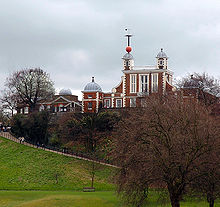

The Sheepshanks Equatorial Telescope was a 6.7-inch (170 mm) aperture refracting telescope installed in 1838 at the Royal Observatory in Greenwich. [1] The telescope was donated to the observatory by the astronomer Richard Sheepshanks. The telescope had a doublet objective lens made by Cauchoix of Paris. [2] Originally it was mounted on a clockwork driven equatorial mounting by the Grubb Telescope Company on a stone pillar. [3] [4]
From 1835 to 1963 it was mounted in Greenwich Observatory's Sheepshanks Dome (located between the later Great Equatorial Building and the Prime Meridian); from 1963 to 1982 it was mounted in the Altazimuth Pavilion. [3] In the early 1980s it was placed in storage. [3]
The focal length of the telescope has been quoted as 6 feet 2+1⁄2 inches (1.892 meters) in one source, [3] but according to another it is 8 feet 2 inches (2.49 meters). [5] The telescope tube was made of wood. [6]
An 1840 report from the Observatory noted of the new Sheepshanks telescope: [7]
The power and general goodness of this telescope make it a most welcome addition to the instruments of the observatory
Still in service over half a century later, an 1896 report by W. H. M. Christie had this to say about the Sheepshanks at that time: [5]
Its definition is good: A small quantity of colour from the secondary spectrum, and a diffusion of light from brilliant objects, being the principal defects.
At one time the Sheepshanks refractor was the largest aperture telescope at Greenwich. [8] One of the instruments for the telescope was a wire micrometer. [5]
Observations
One of its observations was of Comet Encke. [7] The Sheepshanks was used to observe the Moon occulting stars in 1905. [9] [10] Some of the stars that were observed include Bradley 687, 130 Tauri, and 26 Geminorum- among others. [9]
In addition to the occultation of stars by the Moon, the Sheepshanks equatorial is also reported to have been used to observe the moons of Jupiter. [11]
Disambiguation
There are other telescopes bearing the name Sheepshanks, for example the Sheepshanks telescope No 3; this was a telescope of 4.6 inches aperture and 5 feet of focal length, used with a spectroscope in the 1860s. [12] There was also a Sheepshanks telescope at Cambridge, completed in 1898. [13]
See also
- Shuckburgh telescope (1791)
References
- ^ "The Royal Observatory Greenwich - where east meets west: Telescope: The Sheepshanks Equatorial (1838)". www.royalobservatorygreenwich.org. Retrieved 31 October 2019.
- ^ "Trinity College Chapel - Richard Sheepshanks". trinitycollegechapel.com. Retrieved 31 October 2019.
- ^ a b c d "Sheepshanks telescope | Royal Museums Greenwich".
- ^ "The Royal Observatory Greenwich - where east meets west: Telescope: The Sheepshanks Equatorial (1838)". www.royalobservatorygreenwich.org. Retrieved 31 October 2019.
- ^ a b c William Henry Maloney Christie (1896). "Greenwich Astronomical Observations 1893". Greenwich Observations in Astronomy, Magnetism and Meteorology made at the Royal Observatory. 55: 17. Bibcode: 1896GOAMM..55....1C. Retrieved 31 October 2019.
- ^ "The Royal Observatory Greenwich - where east meets west: Telescope: The Sheepshanks Equatorial (1838)". www.royalobservatorygreenwich.org. Retrieved 31 October 2019.
- ^ a b Astronomical Observations, Made at the Royal Observatory at Greenwich, ... Clarendon Press. 1840.
- ^ Tombaugh, Clyde W.; Moore, Patrick (15 September 2017). Out of the Darkness: The Planet Pluto. Stackpole Books. ISBN 9780811766647.
- ^ a b "1906MNRAS..66..342. Page 342". Monthly Notices of the Royal Astronomical Society. 66: 342. 1906. Bibcode: 1906MNRAS..66..342.. doi: 10.1093/mnras/66.5.342. Retrieved 31 October 2019.
- ^ "Observations of occultations of starts by the Moon made in the year 1905, Greenwich, Royal Observatory". Monthly Notices of the Royal Astronomical Society. 66: 342. March 1906. Bibcode: 1906MNRAS..66..342.. doi: 10.1093/mnras/66.5.342.
- ^ Observatory, Royal Greenwich (1889). Introduction to Greenwich Astronomical Observations. H.M. Stationery Office.
- ^ Memoirs of the Royal Astronomical Society. Priestley and Weale. 1869.
- ^ Annals of the Solar Physics Observatory, Cambridge Vol. 1. CUP Archive.